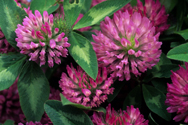
Photo © Steven Foster
Introduction
Red clover is a short-lived perennial herb growing to 1-2 feet that produces purplish-pink tubular flowers.1 Native to Europe, Asia and Africa,2 red clover is widely cultivated for its flowers and as a green manure and nitrogen-rich crop.1 The genus name Trifolium is derived from the Latin tres meaning three and folium for leaf; the species, pratense, is Latin for growing in meadows.3 History and Cultural Significance
Red clover leaves are eaten as salad greens and the flowers are dried for use in teas. The Chinese have traditionally used an infusion of red clover flowers internally as an expectorant, while Russians used an infusion to treat bronchial asthma.2 European cultures also utilized red clover as a medicinal herb to aid in liver and digestive ailments.2 Various Native American cultures ate the leaves as food, and used the plant for sore eyes and in a salve for burns,2 as well as for cough, fevers, and menopause.4 Modern Research
Red clover may be of benefit for the relief of menopausal symptoms.5 One study indicates that a group of red clover’s chemical constituents, isoflavones, may reduce menopausal hot flashes,6 while another suggests that the isoflavones in red clover may decrease bone loss and have a protective effect on the lumbar spine in postmenopausal women.7 Red clover isoflavones have been shown to have a positive effect on blood pressure in certain populations.8 More studies with a greater number of participants are needed to more fully assess these potential benefits. Future Outlook
The use of red clover as a forage crop has stabilized and increased in the United States since 1980.9 Red clover has been recognized for its importance in soil conservation and crop rotation. Chemical compounds have been identified in red clover that are important in animal reproduction processes, protein utilization as well as pharmaceutical products. It is an excellent forage for grazing, hay and silage and will continue to remain important to agriculture in the U.S. and other countries.13 References
1 Bown D. The Herb Society of America New Encyclopedia of Herbs and Their Uses. London: Dorling Kindersley Ltd.; 2001. 2 Kelly G, Husband A, Waring M. Standardized red clover extract clinical monograph. Natural Products Research Consultants 1998. 3 Onstad D. Whole Foods Companion. White River Junction, VT: Chelsea Green Publishing Co.; 1996. 4 Moerman DE. Native American Ethnobotany. Portland, OR: Timber Press; 1998. 5 Huntley AL, Ernst E. A systematic review of herbal medicinal products for the treatment of menopausal symptoms. Menopause. 2003 Sep-Oct;10(5):465-476. 6 Van de Weijer P, Barentsen R. Isoflavones from red clover (Promensil) significantly reduce menopausal hot flush symptoms compared with placebo. Maturitas. 2002:42;187-193. 7 Atkinson C, et al. The effects of phytoestrogen isoflavones on bone density in women: a double-blind, randomized, placebo-controlled trial. American Journal of Clinical Nutrition. 2004:79;326-333. 8 Howes J, et al. Effects of dietary supplementation with isoflavones from red clover on ambulatory blood pressure and endothelial function in postmenopausal type 2 diabetes. Diabetes, Obesity and Metabolism. 2003:5;325-332. 9 Smith R. Red Clover In The “Twenty-First” Century. 2000. Available at: http://www.uwex.edu/ces/forage/wfc/proceedings2000/smith/htm. Accessed March 4, 2005.
|